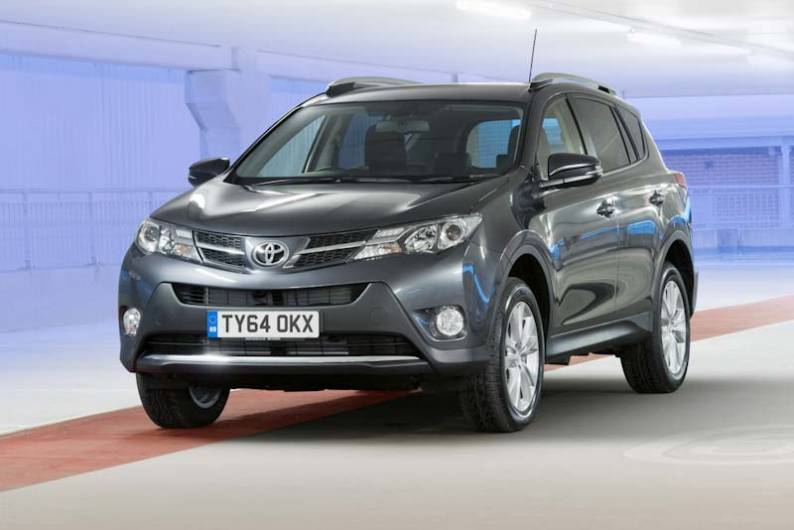
RAC sale – up to 33% off*
• Roadside cover from £5.29 a month†
• We get to most breakdowns in 60 mins or less
• Our patrols fix 4/5 breakdowns on the spot

BY JONATHAN CROUCH
Introduction
Toyota's RAV4 compact SUV soft roader has been around so long it's easy to forget quite how far it's come. The fourth generation model launched in 2013 was bigger, better finished and far more efficient. Nor did it forget that that cars in this class need to look good and drive well too. It's a sensible used buy, but also one that might throw up a few surprises.
Models
5 door compact 4x4 (2.0 VVT-i petrol, 2.0 D-4D, 2.2 D-4D)
History
Think of a small, sporty and relatively affordable soft roading SUV and you're probably thinking of this one, Toyota's RAV4. Since this company's Recreational Activity Vehicle was first launched in 1994, it's redefined its market sector, gaining over four and a half million sales worldwide and spawning a whole host of imitators. These days, some of them aren't even proper SUVs, soft or otherwise, with Qashqai-like crossover models an increasingly popular choice amongst families prioritising style over substance. It all required the RAV4 to evolve in the fourth generation version we're going to look at here, a smarter, plusher, bigger and better to drive model that first hit the market here in early 2013.
Back in the Nineties, the very first RAV was a kind of hot hatch / SUV with three doors and a size no bigger than a modern supermini. A far cry from the mature, grown-up but dare we say, slightly bland family five-door the car had become by the time of the third generation model's launch in 2006. Toyota couldn't turn the clock right back with this MK4 model but it was determined to inject this fourth generation design with a little more styling and driving sharpness, the things, after all, that people most liked about the original.
With these things sorted, so the reasoning went, this car would be as appealing to Qashqai-like Crossover folk as it would be to those considering more traditional soft roading compact 4x4 rivals like Honda's CR-V or Land Rover's Freelander. The MK4 model RAV4 sold in this original form until late 2015, when the range was facelifted, a BMW diesel engine introduced and Hybrid power added to the range for the first time.
What You Get
A RAV4 must never be big and bulky. Buyers have always looked at one and thought 'yes I could drive that', 'yes, I could park it' and 'yes, that would look rather nice in the driveway'. So should loyal owners of first, second or third generation models be worried by the apparently far-reaching changes made to this fourth generation version? After all, it's rather differently sized - 205mm longer, 30mm wider and 25 lower than a MK3 variant - and at first glance very different to look at. It all seems to be evidence of quite a lot of work on Toyota's part - until you start to examine the end result and conclude that really, when you get down to it, nothing too radical has gone on here.
After all, seen in profile, this car still manages to look compact and wieldy, displaying the same kind of space-efficient packaging, rising belt line and distinctive silhouette that previous owners will instantly recognise. Only when you move to the front are major changes apparent, with Toyota's 'keen look' design language liberally applied across the pointy end. That brought us this car's large, trapezoidal lower grille design, matched by a smaller upper grille that runs the full width between sharp-edged headlamps teamed with integral daytime running lights.
Inside, the cabin of this MK4 version features a more stylised feel boasting far better levels of perceived quality. Get in and one of the first things you notice is the curving, metal-finished spar hoop that rises from the transmission tunnel and cuts through the dashboard beams to frame steering wheel, footwell and an instrument binnacle that illuminates with clear blue backlighting.
The central part of the dash meanwhile, is built up in layers, with a rather old-fashioned digital display at the top, surrounded by metallic trim, then a clear effective infotainment screen below before you get to a lower beam that forms a sweeping panel around the ventilation controls and is clad in a soft, pleasing leather-like material you'll also find on the upper door panels. It dominates the eye to such an extent that the buttons below - including that for the important 'Sport' button - are rather hidden away. On the plus side, the redesigned driver's seat is more comfortable, has more adjustment and gives you a wide field of view across the bonnet to make parking easier.
And in the rear? Well if you're coming to this car after owning the previous third generation version, make sure you take a seat here to experience the differences because they really are significant. An extra 100mm has been added to the wheelbase of this MK4 model and pretty much all of it has been used to benefit back seat occupants who get an extra 40mm of kneeroom and class-leading standards of space from seats that can be independently reclined each side of the 60/40 split-folding divide. As a result, you can stretch out in the back of this car in a way that simply isn't possible in many rivals. This alone will sell this car to many family buyers.
And bootspace? Well before we get to that, it's worth pointing out that this MK4 model offered a big change to the way customers could access it. Gone at last was the side-hinged 'fridge-door'-style tailgate arrangement of past RAV4's, to be replaced here by a top-hinged tailgate that was less distinctive but far more user-friendly in tight supermarket carparks. Open it and a big 547-litre loadbay beckons, with a further 100-litres beneath the floor if, rather unwisely, you opt for a variant without a full-sized spare wheel. Use Toyota's Easy Flat system to push forward the seatbacks - they fold almost flat - and you'll free up as much as 1,167-litres - or 1,746-litres, should you feel able to load to the roof.
What You Pay
Please fill in the form here for an exact up-to-date information.
What to Look For
The RAV4 has built an enviable reputation for reliability and this third generation car builds on it. There was a reported issue with the dual mass flywheel on older diesel cars but this issue seems to have been rectified in this model. Most of the owners we surveyed were extremely happy with their cars, though we did come across a few issues. One owner found acceleration dying for no reason, though this was put down to dirty diesel fuel. Another had problems with a fan belt and an air mass sensor. One owner had to replace a cylinder head, while another was faced with a clutch replacement due to what was described as a 'design fault'.
Otherwise, not much goes wrong on-road. Make the normal inspection for signs of heavy off-road use. Since the car was never sold as an 'off-roader', you're unlikely to find that this is a problem. If the vehicle seems to have been used a lot in the mud, it's best to walk away as it isn't built to take that sort of treatment.
Replacement Parts
(approx - based on a 2013 RAV4 2.0 D-4D ex VAT) An air filter is priced in the £6 to £13 bracket, though you can pay in the £16 to 20 bracket if you go for a more expensive brand. A fuel filter costs in the £7 to £9 bracket, though you can pay up to around £22 if you go for a pricier brand. An oil filter costs in the £3 to £10 bracket. On to brakes. A set of pads tend to retail in the £20 to £35 bracket, though you can pay up to around £50 if you go for a pricier brand. Brake discs retail at around £85. Brake callipers retail at around £380. Wiper blades can cost as little as around £5, though you can pay in the £13 to £20 bracket if you go for a pricier brand.
On the Road
Take a seat behind the wheel and to be honest, it doesn't feel like you're in any kind of SUV, positioned as you are 30mm lower than you would have been in the previous generation version. That might be disappointing if you're after this kind of car's classic upright driving position but it'll prove a welcome change for those seeking something a little more driver-orientated.
Is it 'fun to drive'? Well, with any kind of SUV, that's never an easy objective to meet but with rivals (notably Ford and Mazda) showing just how much is possible, Toyota's development team did their best here. As a result, whichever variant you choose - 122bhp 2.0-litre D-4D diesel 2WD, 148bhp 2.2-litre D-4D diesel 4WD and an auto-only 149bhp 2.0-litre petrol 4WD - you'll get a car that compared to its MK3 predecessor, features a more rigid body, re-tuned suspension and revised electric power steering. All of this, it was claimed, improved handling response and helped drivers to maximise the willing performance on offer that across the various models sees 62mph achievable from rest in around 10s on the way to a top speed of between 111 and 118mph.
Does it all work? Well it depends upon the variant you're driving. With the 2WD diesel model, to be frank, the differences over the previous generation version aren't huge. Opt for all-wheel drive though and things are a bit different. Why? Well, it all comes down to the fact that, on all wheel drive models like the 2.2-litre diesel, the 4WD system can now be integrally used in enhancing a more dynamic driving experience - in essence, it potentially can make this car eager and fun again in the way it once was - and that's a big change.
Let us explain. Like most so-called '4x4' cars of this kind, all-wheel drive versions of this Toyota actually run nearly all of their lives with 100% of the power going to the front wheels. Only when there's a loss of traction does any kind of drive head rearwards. Or in a particularly sticky situation, the driver can force 50% of the drive to go rearwards by pressing a dash-mounted 'lock' button. It's all very sensible. But if you're looking for something that'll bring you any kind of spirited drive, all pretty dull.
Which is why the rather hidden away 'Sport' button is so important, offering as it does a third driving option as part of the Integrated Dynamic Drive System - something that makes a big difference to the way this car feels. Select 'Sport' and from the moment you push this RAV into a bend and turn the steering wheel, at least 10% of the drive is pushed rearwards, even on a completely dry and grippy surface. Push harder into the corner to the point where 'understeer' would normally start to develop (that feeling of the car wanting to go straight on as you try and turn) and up to 50% of the drive will be pushed rearwards, taking the pressure off the front wheels and pushing you on round the corner as if guided by an unseen hand. At the same time, steering and throttle response will be sharper, as will the gearshift change points if you've specified auto transmission.
It's all enough to elevate this Toyota towards the kind of driving experience that you'd get from more dynamically able soft roaders like Ford's Kuga and Mazda's CX-5 - and even onto a par with some of the better Crossover models. Providing you use the 'Sport' option of course - or find a RAV4 variant that even has it. We're guessing that many of Toyota's customers won't. For many of them, the 'Sport' button that unlocks this car's dynamic potential will probably get about as much use as the limited off road ability there to take them off the beaten track.
Perhaps that's just as well. With the limitation of just 187mm of ground clearance, you wouldn't want to be tackling anything too arduous in this car. Get yourself somewhere you really need to use the 'lock' button that equalizes torque 50/50 between front and rear axles to ease you up towards safety at speeds of up to 25mph and it's probably somewhere you shouldn't have ventured in the first place. For those remaining undaunted though, Hill-start Assist Control to get you up steep slopes and Down-hill Assist to ease you down the other side are both available. And there's a 750kg unbraked towing capacity across all models, though the 2.2-litre diesel is the best choice for towers given that it has a higher braked towing capacity - up to 2,000kgs in manual guise.
Overall
Though opinion may be divided as to whether the RAV4 invented the soft roading segment, no one doubts that, more than any other, this model defined it. In some ways, it continued to do just that in this early MK4 guise, for this car still sums up most of what a model of this kind should be all about. Smart, wieldy, reasonably spacious, affordable to run and with just enough SUV-ness about it to get you to the places you tend to dream about but will probably never go.
This fourth generation version brought notable changes - extra space and technology, lower running costs and a more dynamic drive - timely improvements, even if there are still other rivals that better it either on or off road. Few though, provide a stronger compromise between the two and none can better the unimpeachable build quality and strong residuals that have become a RAV4 trademark.
Those aren't very SUV-like virtues, but then, neither were limpet-like roadholding and family car standards of ride and refinement before the original MK1 model first hit the scene. This Toyota's approach may have matured over the years along with sharper looks and stronger, more efficient engines, but its buying proposition still makes family-friendly, real world sense.







